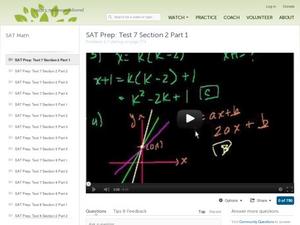Science Buddies
Arduino DC Motor Control with Analog Joysticks
Learn to control DC motors using analog joysticks and an Arduino.
Programming Electronics Academy
Switch Case Application: Arduino Course 5.8
A demonstration of using a switch-case statement in programming.
Packt
Final Keyword in Java
This video explains the Final keyword. This clip is from the chapter "Core Java Tutorial - Part 2" of the series "Selenium WebDriver with Java - Basics to Advanced and Frameworks".This section explores core Java.
Curated Video
Arduino for Beginners - 2022 Complete Course - Variables
This video explains variables. This clip is from the chapter "Programming Basics for Arduino" of the series "Arduino for Beginners - 2022 Complete Course".This section explains Programming Basics for Arduino.
Curated Video
The Art of Doing - Python Network Applications with Sockets - Basic Two-Way Chat Part 1 - Server/Client Setup
In this first part, you are going to learn how to set up our server/client side for our basic two-way chat via terminal. This clip is from the chapter "Creating TCP and UDP Connections with the Socket Module" of the series "The Art of...
Curated Video
Selenium WebDriver with Java - Basics to Advanced and Frameworks - Final Keyword in Java
This video explains the Final keyword. This clip is from the chapter "Core Java Tutorial - Part 2" of the series "Selenium WebDriver with Java - Basics to Advanced and Frameworks".This section explores core Java.
Curated OER
SAT Prep: Test 8 Section 5 Part 4
If your math students are having a hard time with graphing and slopes, this video could be a great resource as they prepare for the SAT. Sal takes care in explaining his thought process, making sure where to note different strategies to...
Khan Academy
SAT Prep: Test 7 Section 2 Part 1
Sal picks up the pace in this video, going through problems 1-7 on page 774 of The Official SAT Study Guide. Basic algebra, arithmetic, and geometry problems start out this section, allowing students to build up some steam before hitting...
Khan Academy
SAT Prep: Test 6 Section 7 Part 4
Clarifying that speed matters more than rigor on the SAT, Sal takes care to show students the most efficient and easiest ways to solve various math problems. Those who get stuck on certain types of problems would benefit from his...
Khan Academy
SAT Prep: Test 7 Section 8 Part 2
Continuing his SAT review session, Sal explores problems with slopes, linear equations, and congruent angles. He begins problem 10 (geometry) but finishes the problem in the next video.
Mathispower4u
Graphing Functions by Plotting Points - Constant
Are you constantly having trouble with constant functions? Learn how to graph these types of functions by watching a helpful video. Viewers follow along as the narrator creates a table of values and plots the resulting points to graph...
Physics Girl
Special Relativity and the Twin Paradox
Everyone knows that one twin is always older in a pair. But, could a twin be years older? A video from an extensive physics playlist explains Einstein's theory of special relativity. Topics include the speed of light, special versus...
Curated OER
What is the Formula for the nth Term in a Geometric Sequence?
What is the difference between an arithematic sequence and a geometric sequence? In an arithematic sequence the constant ratio is added, and in a geometric sequence the constant ratio is multiplied. Watch this video and learn how to use...
Curated OER
Constants (2)
Danny the penguin represents a constant and snow represents variables. This clip is wonderful for learners just starting to understand algebra. It is clear, provides concrete examples, and is totally cute. A great idea for expressing...
Curated OER
How Do You Find the a, b, and c Values of a Quadratic Function?
Writing a quadratic equation in standard form gives values for a, b, and c that can be used to find several pieces of information about the graph of the equation. Knowing a, b, and c-values allows one to find the axis of symmetry, the...
Curated OER
What is the Product Rule for Inverse Variation?
The instructor explains the product rule of inverse variation using the transitive property of equality.










